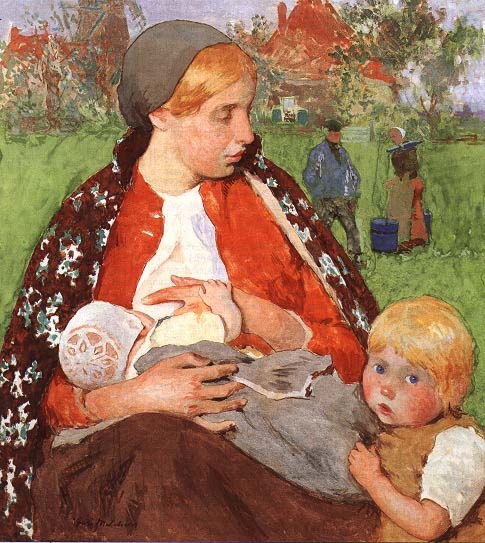
Shaping an Art Collection: Sharing Access to Objects in a Collection
with an emphasis on American Representational Art

(above, Gari Melchers, Madonna of the Fields, 1895, c. 1895, gouache on canvas, 30 x 27 inches, Telfair Museums. Public domain, via Wikimedia Commons*)
Physical sharing
Great pleasure may be derived from sharing access to objects in a personal collection so that members of the public may be further educated and have an opportunity to view objects not otherwise accessible. Also, the financial value of publicly exhibited objects may rise due to the cachet of exhibition in institutions. Since many collectors are active in upgrading or refocusing their collections, lending artworks to museum exhibitions prior to exchange or sale may prove advantageous.
Donations to museums may accompany the lending of artworks. Many museums are concerned about the dilution of their curatorial control through the influence of donations by lenders. For an interesting article on issues museums confront in accepting money donations from art dealers in connection with museum exhibitions of dealers' inventory, please see the November 18, 2007 New York Times article by Jori Finkel "Museums Solicit Dealers' Largess." Since there may be some shared goals between the activities of many collectors and those of of dealers, the article is also of interest to collectors.
TFAO suggests reading it's research reports titled Lending Art to Museums for Special Exhibitions and Planning, Organizing and Touring Art Exhibitions. Also see preparation of agreements within the Exhibitions section of Museums Explained.
TFAO's catalogue Collections of Historic American Art - featuring notable collections assembled by individuals, commercial enterprises and other entities - provides information on collectors who have lent objects from their collections to museums for special exhibitions. Collections also provides insight into the topics pursued by the collectors and their motives for collecting.
Virtual sharing
In addition to lending artworks to museums, private collectors may create personal websites that enable viewers to see images of works in their collection. Images can be presented with enlargement features that provide the opportunity to see small sections of individual works. High magnification can reveal nuances created by individual brushstrokes in paintings. An image of the artist's signature can be included.
Pages containing images of artworks may also include text information such as artist biographies, citations in books and journals, links to other websites and routing information specific to the website. The homepage can contain a link to a page dedicated to biographical information about the collector, including motives and references to sources of information used by the collector.
Example: the site for the M. Christine Schwartz Collection provides images of paintings in the collection, combined with biographical sketches and brief essays researched and written by Dr. Wendy Greenhouse concerning the artists who created the paintings. Images provide a magnification feature which allows viewers to see close-up details of the paintings. The site also contains research suggestions for viewers.
While there are benefits to both the public and collectors for website presentations, there also exists risk of exposure to criminals who may find site information useful for planning thefts. Limiting personal information may be prudent.
Many artworks are subject to copyright law intended to protect intellectual property.rights. Owning an original work of art may not grant to the owner rights for online presentation. For more information please see two articles by Ann Andres: New Law Being Made on Use of Images on the Internet (3/2/00) and Reproduction Rights for Fine Art (4/99).
![]() Return to Shaping an Art Collection
Return to Shaping an Art Collection
![]() Return to Resources for Collectors, Life Long Learners,
Students and Teachers of Art History
Return to Resources for Collectors, Life Long Learners,
Students and Teachers of Art History
Links to sources of information outside of our web site are provided only as referrals for your further consideration. Please use due diligence in judging the quality of information contained in these and all other web sites. Information from linked sources may be inaccurate or out of date. TFAO neither recommends or endorses these referenced organizations. Although TFAO includes links to other web sites, it takes no responsibility for the content or information contained on those other sites, nor exerts any editorial or other control over them. For more information on evaluating web pages see TFAO's General Resources section in Online Resources for Collectors and Students of Art History.
*Tag for expired US copyright of object image:

 Search Resource Library
Search Resource Library
Copyright 2022 Traditional Fine Arts Organization, Inc., an Arizona nonprofit corporation. All rights reserved.